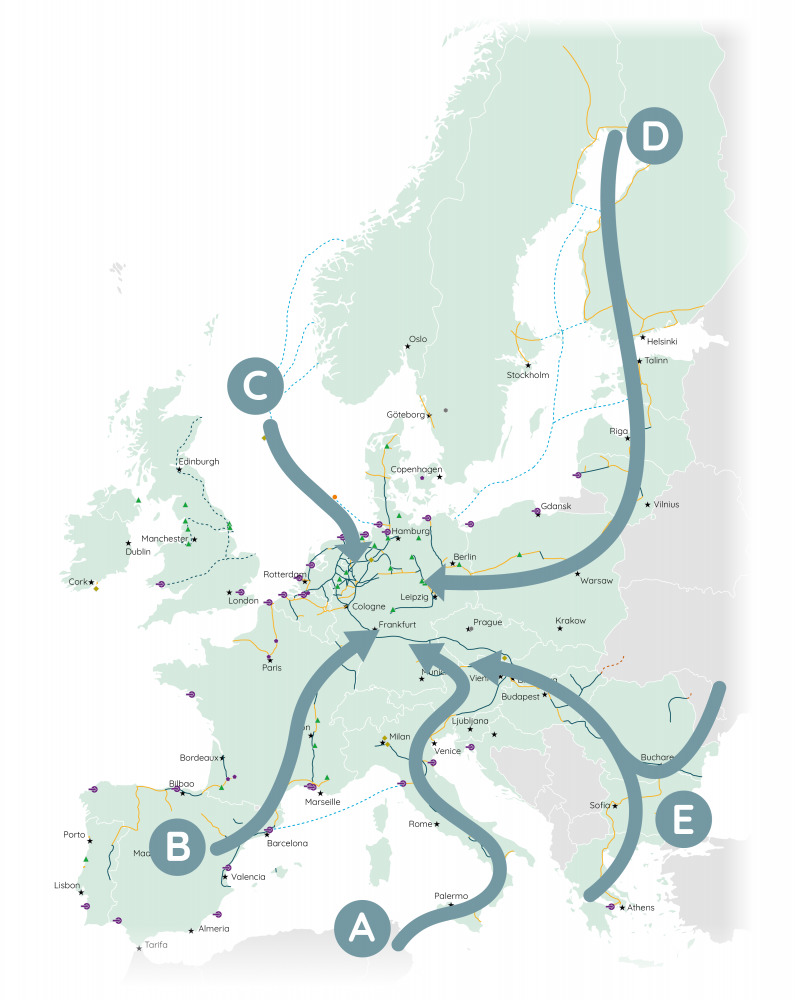ASX Renewable Energy Stocks: European Backbone Initiative says 12Mt of green hydrogen online by 2030
Energy
Energy
A group of 31 infrastructure operators known as the European Backbone Initiative (EHB) has identified more than enough renewable hydrogen supply that is planned to come online by 2030 to meet the EU’s domestic production goals.
At the end of May, the group said five potential hydrogen supply corridors could play a key role to transport large volumes of low-cost hydrogen supply to demand centres across the EU.
The group has identified 12Mt of domestic green hydrogen production that could start up by 2030, surpassing the EU’s target of 10Mt per year of production by 2030.
It also identified 5.4 mt/year of potential supply from countries neighbouring the EU, for a total of 17.4 million mt/year of regional supply.
According to S&P Global, that is in excess of the 14.7Mt per year of demand EBH sees by the end of the decade.

The report, “Five hydrogen supply corridors for Europe in 2030” focuses on the regional sources of green hydrogen, and supply routes.
It plans to build a network of 28,000km of dedicated hydrogen pipelines by 2030, expanding to 53,000km across 28 European countries by 2040.
Around 60% of the network is expected to be made up of repurposed natural gas infrastructure, with the remaining 40% being new pipelines.
EHB sees Central Europe as a significant importer, with large surpluses of supply particularly from North Sea countries and Southern Europe and North Africa.
The five envisaged pipelines connect these supply centres to Central Europe, consistent with the three import corridors identified by the RePowerEU plan, including a corridor via the Mediterranean (Corridors A and B), via the North Sea (Corridor C) and via Ukraine (Corridor E).
However the group warned new and repurposed hydrogen infrastructure would need to be developed to meet the EU’s targets and the hydrogen network ambitions.
It called for incentives to stimulate hydrogen demand, and flexibility in regional regulations to unlock financing for hydrogen infrastructure.
Three exploration licence applications made by MTM at the company’s Ravensthorpe REE-lithium-nickel project in Western Australia’s Albany Fraser region have been granted, taking the total number of grant exploration licences to 11 – covering around 1,400km2.
The area is prospective for a suite of battery metals and critical minerals including lithium, rare earth elements (REE), nickel-cobalt-PGE and graphite, all set to play an important role in renewable energy development and infrastructure as the world transitions to a greener economy.
The Albany-Fraser Orogen, where the Ravensthorpe project is located, is an emerging province-scale ionic absorption clay-hosted rare earth element (ionic REE) opportunity.
MTM has identified historical exploration drilling results on and adjacent to its tenements that indicate prospectivity for ionic REE mineralisation.
Several ASX listed explorers such as Meeka Gold (ASX:MEK) and Mount Ridley Mines (ASX:MRD) have taken up significant landholdings focussing on the ionic REE prospectivity.
CCE and Stand Hewlett Packard are working together on CETO technology, which work by converting ocean wave energy into electricity and desalinated water.
It operates underwater with a fully submerged buoy that drives pumps and a generator, which looks like a metal balloon on a string tied to the sea floor.
The two companies have been collaborating since 2020 and have delivered improvements in CETO’s performance, particularly in relation to the technology’s Reinforcement Learning-based controller.
Reinforcement Learning is a type of Artificial Intelligence where the system teaches itself how to operate optimally.
It can directly apply the optimum response to predicted waves, during operation.
In this case, it learns by being rewarded for the electricity it generates from waves, positioning itself to gain more out of each wave.
HPE is currently exhibiting the CETO tank display at the ISC High Performance 2022 conference in Hamburg this week, to be followed at HPE Discover 2022 in Las Vegas on 28-30 June.